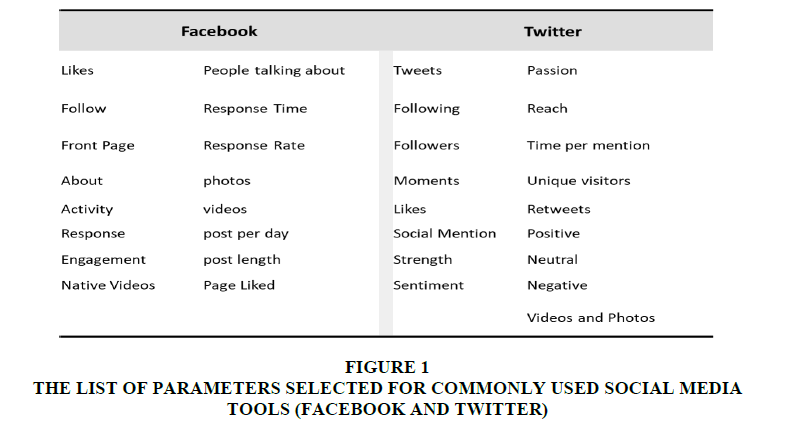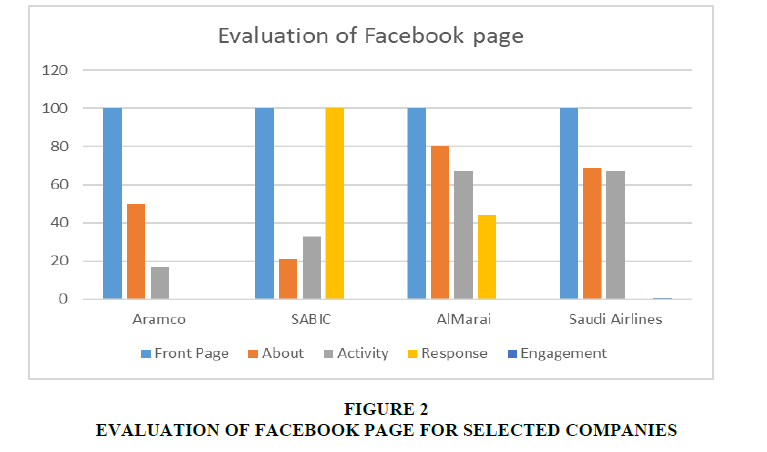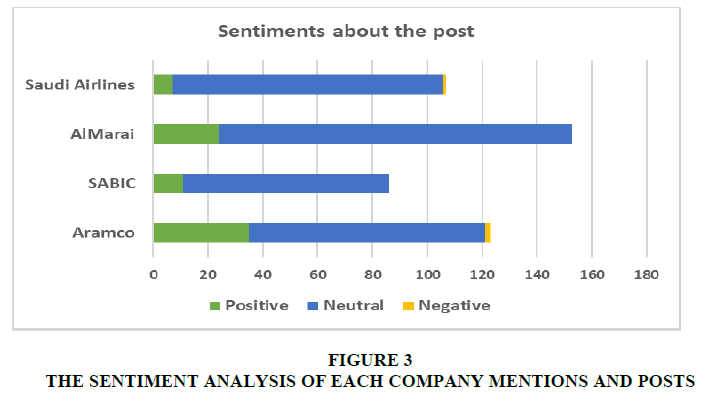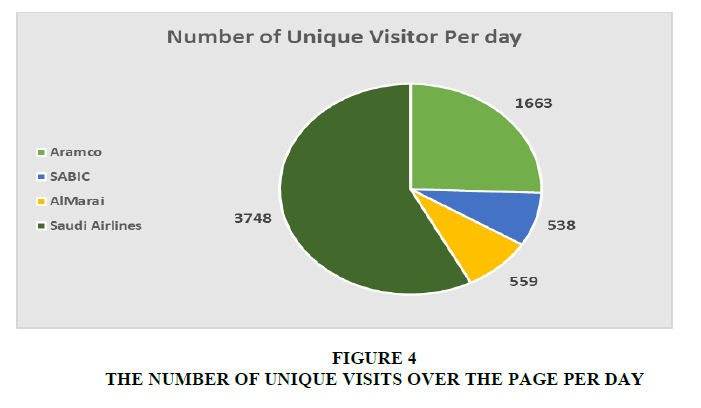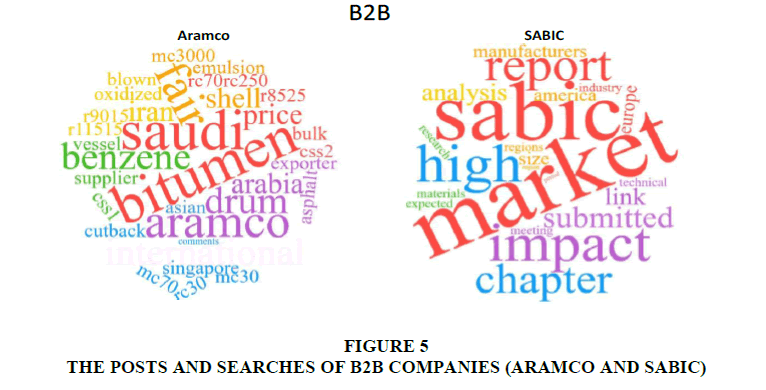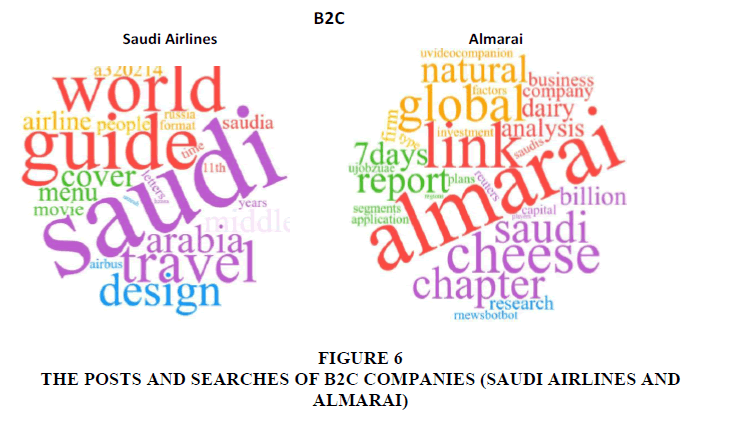Research Article: 2018 Vol: 21 Issue: 1
Predicting the Popularity of Saudi Multinational Enterprises Using a Data Mining Technique
Park, Young-Eun, Prince Sultan University
Mamdouh Alenezi, Prince Sultan University
Abstract
The importance of Multi-National Enterprises (MNEs) located in the Middle East and North Africa is increasing. Especially, the role of Saudi Arabia’s MNEs has been increased as global leaders in line with Saudi Arabia’s Vision 2030 plan. However, the existing literatures focus mainly on informative issues, those do not fully capture the opportunities with checking up on consumers reactions or perception over those firms. Accordingly, in this study, we explored consumers’ reactions through social media, such as Facebook and Twitter to predict future popularity and trends of firms. This was done by analysing the pattern on consumers' preference for Saudi Arabia’s four leading, multinational companies via data mining technique, sentiment analysis. The result shows that social media would be a powerful and valuable tool to forecast future popularity of multinational enterprises. Moreover, this study has a significant implication practically for business decision-making using social media to expand business globally.
Keywords
Multinational Enterprises, Social Media, Sentiment Analysis, Data Mining, Prediction.
Introduction
Nowadays each individual as a customer spills out data on Instagram, Twitter, Facebook, Snapchat, and YouTube as well and so on. Accordingly, those tools have changed how people demand their rights and express their opinion and this leads to having a huge impact on people’s lives even the business world as well (Azam, 2015). Initially, Facebook was a truly social networking site where people around the world build a relationship with others and share their feelings. However, those social networking sites now became the major sources to better understand customers, furthermore, human interactions, its nature, and relationships overall. Thus, social media has been an eminent means in transforming the way people interact and connect with one another and has brought many positive outcomes (Nguyen, 2018). Moreover, in terms of purchasing goods, users of social media can create information from the huge online database to make their own decision (Nguyen, 2018). A large amount of user-generated content became now freely available on many social media sites (He et al., 2017). Social media as an independent variable plays a critical role in affecting purchase decision and its usage also impacts business decision-making as well (Mathupur et al., 2012). Especially, social media has been emerging as a new power in the Middle East region. Based on that, many studies about the use of social media for social and other purposes in this region have been found recently (Park et al., 2017). However most studies have covered the only general information as a tool to identify and explore the perception of social media, the role and expectation briefly with users or customers perspectives on political or social issues (Ali, 2011; Abdulaziz, 2013; Jarid, 2016; Park et al., 2017).
Saudi Arabia has the largest economy in the Arab region and the most promising country, which has 38% of the total Arab GDP (Gross Domestic Product). That means it is the powerhouse of the Middle East (Kavoossi, 2000; Park et al., 2017). Based on Saudi Arabia’s “Vision 2030” plan, which is an achievable blueprint that expresses a country’s long-term goals and expectations, strengths and capabilities, the Saudi government encourages Saudi multinational enterprises’ proactive actions to be world business leaders. Accordingly, this study focuses on Saudi multinational companies as a research target and making their strategy by exploring the perception and the role of social media as a powerful tool to predict their preference or popularity in the global marketplace.
Saudi Arabia has the largest economy in the Arab region and the most promising country, which has 38% of the total Arab GDP (Gross Domestic Product). That means it is the powerhouse of the Middle East (Kavoossi, 2000; Park et al., 2017). Based on Saudi Arabia’s “Vision 2030” plan, which is an achievable blueprint that expresses a country’s long-term goals and expectations, strengths and capabilities, the Saudi government encourages Saudi multinational enterprises’ proactive actions to be world business leaders. Accordingly, this study focuses on Saudi multinational companies as a research target and making their strategy by exploring the perception and the role of social media as a powerful tool to predict their preference or popularity in the global marketplace.
Literature Review
Saudi Arabia’s Multinational Enterprises
Saudi Arabia is the largest economy in the Middle East and North Africa (MENA) as a part of the G-20 summit and also the 20 largest economies in the world (Bassam, 2015; Park et al., 2017). Moreover, Saudi Arabia is the largest producer of oil. Oil revenues accounted for 89.7 ~ 91.7% of total revenues for Saudi Arabia from 2006 to 2012. Thus, Saudi Arabia plays an important role in shaping the world economy, economically and politically as well even though many issues have been generated related to political chaos and conflicts in this region (Bassam, 2015; Park et al., 2017). Considering the cynical news coverage portraying the Middle East as a region in constant disturbance and trouble, one would expect it to be a completely unsafe and inconsequential market for multinational enterprises while they have grown dramatically in size and influence in this region over the last two decades. Now Middle East is home area to many of the world’s largest global companies also including Saudi multinational enterprises such as Saudi Aramco, SABIC, AlMarai, Saudi Arabia Airline (Saudia), most of which enjoy a lucrative business from their operations in this region (Kavoossi, 2000).
Arabia has faced fluctuating oil prices controlled by global forces over the past 18 months. Saudi Arabia realizes the potential, and also opportunities of its non-oil economy not to depend on oil-based economy anymore. Accordingly, the Saudi government has invested heavily in IT, infrastructure, health and education (Jin & Yoon, 2016). Therefore, now it is critical time to find a real opportunity for Saudi Arabia to develop the country and inject new dynamism and power through new strategy and investment led transformation that could help ensure bright future and prosperity (Park et al., 2017). The country catches significant opportunities to transform its economy to become more competitive and less dependent on oil. The Saudi government has made efforts consistently to diversify its economy through encouraging Saudi multinational companies to generate competitive advantages and extend markets in the world, and also seeking inward Foreign Direct Investment (FDI) in a wide range of sectors from out of the country (Bassam, 2015; Park et al., 2017). For this new transformative actions, the role of Saudi Arabia’ multinational companies became significantly important to lead the country’s future in the world economies. For example, among transformative action programs, there is a “Saudi Aramco Strategic Transformation program”. Saudi Aramco is one of the world’s largest oil companies and possesses the largest oil reserves. It supplies 10% of global demand and regulates global markets. With this asset, Saudi Aramco has the ability to lead the world in other sectors besides oil, and it has worked on a transformative program that will position it as a global leader in more than one sector. Likewise, there are many leading companies such as Saudi Aramco, SABIC, AlMarai, Saudi Airlines, Al Rajhi Bank, STC, NCB, Jarir, Mobily, Bupa and so on which want to take transformative actions to be leaders in Saudi Arabia. However, there is a limitation that academic research data is very scarce when it comes to Saudi Arabia’s companies and especially no reliable sources in this region due to reluctances to leak business information, conservative cultures and business trends as well (Bassam, 2015; Park et al., 2017; Park, 2018).
Predicting Social Media Data using Data Mining Techniques
Data mining is the process or set of processes of extracting data from a huge volume of data sources and transform it into an understandable format with the context for future use, especially to achieve business insights (Dhana et al., 2015; Park et al., 2017; Milanjit & Komal, 2018). This allows the users to check the different aspects of the data and assembles them to reach a valuable conclusion (Milanjit & Komal, 2018). Data mining has various applications. Among them, sentiment analysis can be used with common sense with the help of septic computing, a component of a small scale system (Milanjit & Komal, 2018). Sentiment Analysis is pitched into this process as a part of it since it is the process of identifying, analyzing statements and finally obtaining subjective information from them. That is, this analysis involves the usage of text scrutiny and processing in order to recognize the patterns plus gain useful information. Data is collected from various social media sources that contain comments, review and various information related to the respective business. Through this approach, predictions are made according to, basically, the past behavior, pattern of sales, posts on Facebook, tweets on twitter, and so forth. This set of predictions is used to achieve success in business by capturing customers reactions using various social media sources. Indeed, it leads to striving to achieve a varied range of business outcomes positively (Dhana et al., 2015; Park et al., 2017; Milanjit & Komal, 2018). Many studies have tried to find out some insights from social media data using data mining techniques in medical, business and several areas.
Especially, in the business field, predictive analytics has recently been popular in forecasting the occurrence of dealings and the stock price for the upcoming day, using the data from social media such as Facebook or Twitter. This model was developed by Riverside and other colleagues. Li et al. (2012) created a trading strategy supported by this model. Its trading strategy showed better predictions than other baseline strategies. Moreover, this strategy outperformed the Dow Jones Industrial Average with a 4 month simulation. Hristidis’s study showed better and further effect than negative and positive sentiment analysis on stock prices, using the number of tweets and also the interdependence between users, topics and tweets. Recently, Omar (2015) has discussed the relationship between Facebook popularity and stock prices related to a consumer brand. The aim of this study is to determine whether popularity measured “likes” in Facebook affected performance by stock prices. He recognized 30 brands that had the largest number of followers and tracked the likes these companies got over a period of one year as well as their stock price on a daily basis. As a result, he identified that 99.95% of the changes in a price of a share of stock could be demonstrated by the variation in the number of followers. Even he did not see a direct relationship between Facebook likes and an increase or decrease in stock prices, however, stock market’s overall trends were affected by the appreciation a company got on social media. The majority of a change in a specific company’s stock price was linked with the Facebook likes that brand received within the given period. Finally, the data of social media sentiment has become most applicable to produce other predictive models. Park et al. (2017) examined the analysis of pattern on Arab countries consumers' preferences of the Korean entertainment contents via a social media such as a Facebook since Korean dramas, movies and pops have been distributed in the global markets. Then, they developed a predictive model using a data mining technique to forecast future patterns and trends.
However, most existing studies tend to focus mainly on either the role of digital breakthrough of predictive analytics through data mining techniques or social media based on customer-oriented perspectives without full discussion their tie-up between data mining technique and social media in business. Based on previous studies and our awareness of these weak points, we use data mining technique to create predictive models with social media, especially, sentiment analysis for the decision-making in business. In this study, we, thus, engage in the notion of spreading social media in disseminating Saudi Arabia’s multinational companies and developing predictive models of Saudi enterprises’ popularity or preference in the global marketplace as a strategic tool.
Methodology
The objective of this study is to use predictive methods to know the popularity or preference for Saudi Multinational companies, which operate internationally in the global marketplace. Finally, it aims to search the best ways to gain sustainable competitive advantages through this prediction system. For this study, we used a data mining technique as a main analytical tool. Data mining is a popular and overwhelming apparatus in the process of observation identification and knowledge discovery in data warehouse in which are applied in order to extract patterns and find a trend. Predicting is one of the most interesting, yet, mysterious and difficult tasks where to build data mining applications. Using computers with programmed tools, a large amount of data are being collected. Among data mining techniques, the sentiment analysis is often applied to internet texts such as Facebook likes, tweets, product reviews, websites or blog, where automatically determining published feeling towards a product or service is very useful to marketers, analysts or decision-makers for strategy. The main aim of sentiment analysis is to distinguish the polarity or divergence of natural language text, that is, positive, neutral and negative contents (Dhana et al., 2015; Charlorthorn, 2016; Park et al., 2017; Milanjit & Komal, 2018). Accordingly, the data mining techniques, research groups will develop many kinds of models with various topics to enhance forecasting in the business and medical fields as well (Shweta, 2012).
This research focused on social media data collected from two major categories of business: (1) Business to Business (B2B, referring the transactions or exchange of products or services between businesses); (2) Business to Consumer (B2C, referring to the transactions conducted directly between a company and consumers as an end-users of its products or services). The data was collected from the companies that are located in the Kingdom of Saudi Arabia (KSA) based and is mainly operating in the Middle East region. The selection of companies was made using the following criteria:
1. Must be recognized by Ministry of Commerce, in the Kingdom of Saudi Arabia (MOC).
2. Must be in Top 20 category for ranking published by MOC.
3. The popularity is quite locally and regionally.
4. Must have their presence on the social media.
5. All of them are working for National Transformation Plan 2020 (NTP 2020) in KSA
So, out of those companies, two from each business model were selected that are presented in Table 1.
| Table 1 The List Of Companies Selected Along With Selection Criteria Fulfillment |
||||||
| No | Company Name | Model Type | Regional Presence | Social Media Presence | Top20 Ranked | Contributing to NTP 2020 |
| 1 | SABIC | B2B | KSA, Middle East |
? | ? | ? |
| 2 | Aramco | B2B | International | ? | ? | ? |
| 3 | Almarai | B2C | KSA, Middle East |
? | ? | ? |
| 4 | Saudi Airlines | B2C | International | ? | ? | ? |
The data was collected using a tool developed in PHP and JavaScript that used the API provided by Facebook and Twitter to extract the data from it about each company separately. Using this tool, the sentiment analysis was done for this research. It is about the prediction of the sentiment of people for that post. It helps in predicting the overall popularity as well as it will also tell the perception of people about the company.
This research focused on the data that is collected from start till October 2018. This data is open source for all as it is acquired from the pages of companies so the post is made from the companies while the audience can be any. Those user-generated contents became now freely available (He et al., 2016). However, it can be seen from results that penetration of the market is not more than a gulf. Mainly, the collected data focused on the post reach, the post made, total likes etc. as shown in the Figure 1.
Figure 1: The List Of Parameters Selected For Commonly Used Social Media Tools (Facebook And Twitter)
Second, this research also focused on post reach for each company and compared it as companies and category. For this, the evaluation of each company page was made and then engagement was calculated. Third, the research focused on finding how are posts made that refers to the content of posts and what people say about the companies. For this sentiment analysis such as positive, neutral and negative posts, contents were evaluated. Fourth, this research also looked into the market penetration socially using a number of unique visitors over social media, unique people talking about.
Results
This study shows the result of quantitative analysis on Facebook and Twitter content. Table 2 shows the selected 4 companies (Aramco, SABIC, AlMarai, Saudi Airlines) presence over Facebook and Twitter till October 2018. It is seen that B2C companies have more likes and followers compared to B2B that speaks for itself while B2C focuses on consumers since social media presence belongs to normal consumers more than that of B2B. It is seen that in terms of numbers of Facebook clearly the services sector of B2C have more likes compared to product provision sector.
| Table 2 The Selected Companies Presence Over Facebook And Twitter |
|||||||
| B2B | B2C | ||||||
| Aramco | SABIC | AlMarai | Saudi Airlines | ||||
| Likes | 28,343 | Likes | 305,864 | Likes | 4,863,771 | Likes | 5,561,077 |
| Follow | 29,197 | Follow | 306,153 | Follow | 4,859,996 | Follow | 5,559,640 |
| Tweets | 5300 | Tweets | 1094 | Tweets | 32K | Tweets | 93.3K |
| Following | 11 | Following | 1 | Following | 8 | Following | 27 |
| Followers | 1.1M | Followers | 1006 | Followers | 360K | Followers | 1.08M |
| Moments | 13 | Moments | Moments | Moments | |||
| Likes | Likes | 6 | Likes | 2089 | Likes | 760 | |
| Videos and Photos |
2756 | Videos and Photos |
891 | Videos and Photos |
5599 | Videos and Photos |
3378 |
Key: K: thousands, M: Million.
It is seen that the presence of sector globally affects the number of followers. A number of followers represent the people who would like to listen about particular company news. These followers may be mostly public, as well as investors, stockholders, competitors or job seekers. As shown in Table 3 that a number of followers are above 1000% compared to tweets made for B2C sector, the number of followers is above 20K% in terms of heavy global impact organization while SABIC has an impact of 92% due to its less presence in the market in terms of outreach and jobs opportunities, although the number of Facebook posts are more than Aramco. It is also seen that number of video and photos are shared in B2B sector that may relate to some advertisement, national day messages etc. like for SABIC the 82% of tweets are already in form of videos and photos. Over twitter, B2C often gets likes while B2B does not have any likes except SABIC with six likes overall.
| Table 3 The Comparison Of Followers Over Likes And Tweets |
|||||
| Aramco | SABIC | AlMarai | Saudi Airlines | ||
| Likes/Followers | 97.08% | 99.91% | 100.08% | 100.03% | |
| Followers/tweets | 20754.72% | 91.96% | 1125.00% | 1157.56% | |
Figure 2 shows the evaluation of Facebook page for selected companies. Each company has their “Facebook page” that contains contact information as well as basic information. The second thing is ‘About’ company, which is built less than 50% for the B2B companies while B2C companies have above 50% information that should be 100%. Another element in comparison is “Activity” that seems too low for B2B companies less than 40% while for B2C companies even it is too low that is around 65%. The “Response time” for each company, except SABIC is too low that should be higher in B2C companies. While “Engagement” of post that refers to how many people liked, shared the post or talked about the post are none.
As Table 4 illustrates, most of the post have positive sentiments compared to negative. None of the tweets is retweeted that shows less engagement in the post. The sentiment that is usually mentioned is mostly neutral and positive and less negative that also reveals that post is ok. However, a number of neutral sentiments are more than positive sentiments that shows that people are averagely enthusiastic as shown in Figure 3.
| Table 4 The Impact Of The Strength Of Post As Well As How Far It Reached |
||||||
| Social Mention | Description | Aramco | SABIC | AlMarai | Saudi Airlines | Type |
| Strength | 46 | 42 | 39 | 45 | % | |
| Sentiment | 13:01 | 11:00 | 23:00 | 7:01 | Positive: Negative | |
| Passion | 66 | 50 | 68 | 41 | % | |
| Reach | 18 | 29 | 18 | 30 | % | |
| Time per mention | 2 | 1 | 1 | minute | ||
| Unique visitors | 36 | 43 | 18 | 59 | person | |
| Retweets | 0 | 0 | 0 | 0 | ||
| Positive | 35 | 11 | 24 | 7 | ||
| Neutral | 86 | 75 | 129 | 99 | ||
| Negative | 2 | 0 | 0 | 1 | ||
Figure 3 shows that no positive sentiments in B2B are higher as of Aramco and when analyzed it is seen that Aramco has a couple of activities and resorts where people enjoy. Moreover, least positive sentiments are for Saudi Airlines that should be higher as no of positive sentiments directly relates to trust in the company and affects business such as there is one negative sentiment that may be due to some service issues.
In addition, if seen in Table 4 the number of unique visitors are very low that means the reach to people is too low with a max of Saudi airlines but on the other hand, the lowest are also B2C that is for Al Marai. Figure 4 shows the number of unique visitors per day and it shows that B2C has more visits due to Saudi Airlines but overall as average the visitors in B2B are more than B2C.
Figure 5 shows the posts and people searches related to B2B Companies (Aramco and SABIC). This illustrates the way people searched about Aramco and how their post is while in part b about SABIC. It is seen that the major portion of searches for SABIC is itself SABIC and its market while there is some focus on research, analysis and meetings. While Aramco posts are related to Aramco, Saudi and types of oil crude that are being extracted thus related to their business. So both companies have different kind of posts that means Aramco focuses on their producing products in posts while for SABIC usually, it used for sharing reports and outcomes.
Figure 6 shows the B2C companies that are selected and their key posts as well as searchers, it is seen that there are not many words used in Saudi airlines except the travel, guide, and world that refer to the usage of their social media for just announcement and publicity. While AlMarai has added its new product into posts that refer to marketing, sharing its reports and research and contribution. Thus, AlMarai is using more words and this can be related to more positive sentiments received, as mentioned in Table 4.
Based on those results, we have found some valuable findings as follow.
First, a firm can leverage huge volume of social media data to extract valuable information and knowledge about customers’ response, perception and reaction generally for business decision-making. That is, a firm can use social media as a competitive intelligence tool to design a marketing or communication system and its process. Second, according to its business types such as B2B and B2C, it seems that a firm needs to use a different, two-track strategy to use social media as a marketing or strategic tool. Especially, the results show that a firm needs to consider each type of stakeholders such as the public, investors, stockholders, job seekers, regulators, even competitors to improve business advantage through social media. Since main stakeholders are different between the two business models. With predictive analytics, a firm no longer relies on the experience as a rear-view mirror; it must go forward by serving their main stakeholders. Lastly, through predictive analytics using social media data, a business can deliver superior and personalized customer experience and customer excellence as well by analyzing what they would be needing and wanting in a comprehensive manner in the near future. With a reliable predictive analytics system, businesses can analyze all the structured (such as demographic and geographic data) and unstructured (customer inputs from social media) data and forecast customer expectations. Furthermore, this tool can help in detecting hidden insights in customer data. Since customers’ comments and any suggestions can drive the fate of a company and influence influencers to make the best use of social value metrics. Additionally, businesses must be aware of a situation that getting close to the customer is no longer the priority of the marketing and sales team only; it must be the duty of all members in a company. Then, this applies to various future businesses as well, including app development or customized services to build a long-term relationship.
Conclusions
Aiming to analyze the popularity of Saudi Multinational enterprises, we embraced a data-driven approach through Data Mining technique. The collected data represent a chronological sequence of observations such as a time-series on a number of likes by country associated with public pages (Aramco, SABIC, AlMarai, and Saudi Airlines). Predicting future likes trends of Saudi multinational companies can anticipate future consumer behavior, especially consumption in order to maximize the long-term profitability and finally success in the end. Accordingly, in this study, we expect some significant and valuable implications as follows.
First, this study has found that consumer’s awareness or perception and attitude towards Saudi multinational companies in the global marketplace are sometimes an entryway or first step to a more outspread interest in Saudi Arabia’s products and brands or itself. By increasing the awareness of Saudi Arabia as a whole, companies can promote foreign consumers’ buying behavior on Saudi Arabia’s products and services, generally. Moreover, it can remove any entry barrier and create some opportunities for Saudi companies, which seek to operate a business not only in Arab countries but also in Europe, Asia, North America and Latin America and so on. Thus, by measuring consumers’ preference and popularity on the Saudi MNEs worldwide, we can forecast the company’s near future and prepare for next plans to generate sustainable competitive advantages. Second, this study gives a valuable insight to develop a predicting model using social media data through data mining technique. It would be a powerful tool to find a trend on Saudi companies in the host countries and build a model for popularity forecasting. From this, Saudi MNEs can reduce operating cost, monitoring cost, marketing cost and time as well by not having to detect the trend manually. Moreover, with this predicting modeling, companies can analyze several issues such as a relationship between stock prices and popularity through social media, or between profitability, market share and preference through social media. Lastly, this study has found that multinational companies need to consider two tracks strategy to be taken according to their business styles. That is, the different strategy must be done between B to B and B to C to serve their main stakeholders. Because the purpose of using social media is quite different between the two groups.
Even though the findings of this study were very noteworthy and significant overall, still there are some limitations. First, the data source for this research is open to all as it is acquired from the pages of companies. The post is made from the companies while the audience can be anyone worldwide even it can be seen that penetration of the market is not more than gulf regions from the results. Accordingly, a comparative study between Arab countries and other regions also can be possible for future research if the data is divided separately between the regions. From this study, we can drag some valuable points for Saudi companies to make a unique strategy on Arab regions such as different marketing approaching based on the characteristics of these regions compared to other host countries. Saudi companies are able to bear in mind the cultural elements of the Middle East and vice versa. Considering these unique points, companies can produce distinctive products or services to integrate with each country’s culture or other unique characteristics. Second, another important feature of the model would be comparative study among B2B and B2C business models to create a general prediction analytics. It can be considered for future research. Third, this mining approach for extraction is based on static keywords appearing in single comments or review document that may omit even relevant or more comprehensive review. Thus, it needs to analyze based on multiple features or attributes to improve in accuracy and efficiency of existing techniques as a further research.
Acknowledgment
This work was supported by the Research Grant Project of Prince Sultan University; Saudi Arabia grant number IBRP-CBA-2016-12-15. The authors thank Mr. Yasir and Mr. Uraiza of Prince Sultan University for their valuable assistance for this paper.
Authors
First and Corresponding Author:
Park, Young-Eun
Assistant Professor, Management Department, College of Business Administration,
Prince Sultan University, Kingdom of Saudi Arabia.
Tel: +966-11-494-8564,
E-mail: ypark@psu.edu.sa.
Co-Author:
Mamdouh Alenezi
Associate Professor, Computer Science Department, College of Computer & Information Sciences,
Prince Sultan University, Kingdom of Saudi Arabia.
Tel:+966-11-494-8441,
E-mail: malenezi@psu.edu.sa.
References
- Ali, A. (2011). The liower of social media in develoliing nations: New tools for closing the global digital divide and beyond. Harvard Human Rights Journal, 24(1), 185-219.
- Abdulaziz B.A. (2013). A survey of social media users in Saudi Arabia to exlilore the roles, motivations and exliectations toward using social media for social and liolitical liurlioses. Master Thesis, Arkansas State University.
- Azam, O. (2015). Social media imliact on arab sliring, a comliarison study between four middle eastern countries. Master Thesis, Hawaii liacific University.
- Bassam, A. (2015). Does Saudi Arabia’s economy benefit from foreign investments? Benchmarking:Bradford, 22(7), 1214-1228.
- Charlorthorn, T. (2016). Quantitative assessment of factors in sentiment analysis. Doctoral Thesis, University of Northumbria at Newcastle (UK).
- Dhana, L.li., Ramani, K., &amli; Eswara, R. (2015). Feature relevance analysis in on-line marketing to imlirove liroductivity. I-Manager’s Journal on Software Engineering, 9(3), 1-10.
- He, W., Tian, X., Chen, Y., &amli; Chong, D. (2016). Actionable social media comlietitive analytics for understanding customer exlieriences. The Journal of Comliuter Information Systems, 56(2), 45-155.
- He, W., Wang, F.K., &amli; Akula, V. (2017). Managing extracted knowledge from big social media data for business decision making. Journal of Knowledge Management, 21(2), 275-294.
- Jarid, T.I. (2016). The relationshili between the internet, social media, customer lireference, and customer loyalty in the hotel industry. Doctoral Thesis, Caliella University.
- Kavoossi, M. (2000). The globalization of business and the Middle East: Oliliortunities and constraints. Westliort, CT: Quorum Books.
- Li, D.C., Chang, C.J., Chen, C.C., &amli; Chen, W.C. (2012). Forecasting short-term electricity consumlition using the adalitive grey-based aliliroach-An Asian case. Forecasting in Management Science, 40(6), 767–773.
- Mathuliur, li., Black, J.E., Cao, J., Berger, li.D., &amli; Weinberg, B.D. (2012). The imliact of social media usage on consumer buying behavior. Advances in Management, 5(1), 14-22.
- Milanjit K., &amli; Komal, A. (2018). Role of various data mining techniques in sentimental anlysis. International Journal of Advanced Research in Comliuter Science, 9(3), 178-180.
- Nguyen, T. (2018). The imliact of hallyu 4.0 and social media on korean liroducts liurchase decision of generation C in Vietnam. Journal of Asian Finance, Economics and Business, 5(3), 81-93.
- liark, Y.E (2018). The endless challenges of KIA motors for globalization: A case study on kia in Saudi Arabia. International Journal of Industrial Distribution &amli; Business, 9(9), 45-52.
- liark, Y.E., Allawiya, A., &amli; Raneem, A. (2017). Determinants of entry modes choice for MNEs: Exliloring major challenges and imlilications for Saudi Arabia. 1st AUE International Research Conference, in Dubai UAE, Sliringer.
- liark, Y.E., Chaffar, S., Kim, M.S., &amli; Ko, H.Y. (2017). liredicting Arab consumers lireferences on the Korean contents distribution. Journal of Distribution Science, 15(4), 33-40.
- Shweta, K. (2012). Using data mining techniques for diagnosis and lirognosis of cancer disease. International Journal of Comliuter Science, Engineering and Information Technology, 2(2), 55-66.
